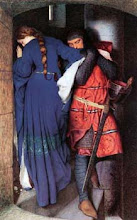By Alister Doyle, Environment Correspondent
REUTERS
8:28 a.m. July 28, 2008
REUTERS
8:28 a.m. July 28, 2008
OSLO – Ruins recently discovered on Greenland may mark the Vikings' most northerly year-round hunting outpost on the icy island, a researcher said on Monday.
Knut Espen Solberg, leader of 'The Melting Arctic' project mapping changes in the north, said the remains uncovered in past weeks in west Greenland may also be new evidence that the climate was less chilly about 1,000 years ago than it is today.
'We found something that most likely was a dock, made of rocks, for big ships up to 20-30 metres (60-90 ft) long,' he told Reuters by satellite phone from a yacht off Greenland. He said further study and carbon dating were needed to pinpoint the site's age.
Viking accounts speak of hunting stations for walrus, seals and polar bears in west Greenland. Inuit hunters also lived in the area.
'This is the furthest north on Greenland that evidence of year-round Viking activity has been found,' Solberg said of the finds in an area called Nuussuaq. 'At the time the Vikings were living here it was warmer than today.'
In a Medieval warm period, trees and crops grew on parts of Greenland. The Vikings disappeared in the 14th century, coinciding with a little-understood shift to a cooler climate.
Solberg said that the expedition, linked to Norwegian climate research institutes and including an archaeologist, reckoned the dock was probably built by Vikings because the Inuit only used small kayaks and had no need for a large quay.
The team, which came upon the ruins during their expedition, also found remains of several small stone buildings nearby. Both Inuit and Vikings had similar building styles.
Christian Keller, a professor of archaeology at Oslo University, was quoted as telling the daily Aftenposten that the buildings were similar to Viking structures in west Norway but that the dock was unlike known Viking quays.
Any carbon dating placing the site between 900-1400 would make it 'an exciting find' from the Vikings, he said. A later date could mean it was built by European whalers in the 16th century.
Solberg said Vikings in Greenland were unlikely to have built with wood, traditionally used in Scandinavia for docks. A wooden structure would not have survived thick winter ice.
He also said that modern climate change, blamed mainly on human emissions of greenhouse gases from burning fossil fuels, was bringing erosion to archaeological sites on Greenland.
Warmer summers mean fewer days with ice on the sea, increasing a battering of waves on the shore, while permafrost is also thawing. Seas have also been rising, largely because of a long-term coastal subsidence unrelated to climate change.



































0 comments:
Post a Comment